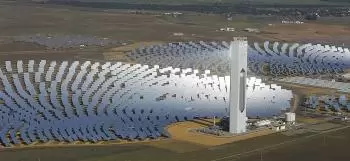
A solar thermal power plant, also known as a solar thermal power plant, is an industrial installation designed to take advantage of solar radiation and transform it into electrical energy.
Although its operating principle is similar to that of conventional thermal power plants, it differs in a fundamental aspect: the heat source used is not of fossil origin, but is based on solar energy.
How does a solar thermal power plant work?
The operation of solar thermal power plants is based on obtaining heat from solar radiation and transferring it to a heat carrier medium, which is generally water.
To raise the water temperature to the desired high levels, maximum solar radiation must be concentrated at one point. In this way, temperatures of 300ºC to 1000ºC can be obtained, which will be used to generate steam. The higher the temperature, the greater the thermodynamic performance of the solar thermal power plant.
The accumulation of thermal energy is used to produce steam that can drive steam turbines. With the movement of the turbines, mechanical energy is transferred to the electrical generators to generate electricity.
Solar energy concentration systems
The capture and concentration of solar rays is done through mirrors with automatic orientation that point to a central tower where the fluid is heated. Some solar thermal power plants use smaller parabolic geometry mechanisms such as parabolic trough collectors.
The assembly of the reflective surface and its orientation device is called a heliostat.
Thermodynamic cycles
In the experimental setups, various flows and thermodynamic cycles are used.
These cycles range from the Rankine cycle, used in nuclear power plants and coal-fired power plants, to the Brayton cycle, common in natural gas plants. In addition, numerous variants have been developed, such as the Stirling engine. Among the most frequent cycles are those that integrate solar thermal energy with natural gas.
Efficiency of a thermoelectric plant
The efficiency of a concentrated solar energy system will depend on the following factors:
- The technology used to convert solar energy into electrical energy.
- The operating temperature of the heat receiver.
- Thermal losses in the system.
- The presence or absence of other system losses
In addition to the conversion efficiency, the optical system that concentrates sunlight also adds additional losses.
The maximum conversion efficiency for "power tower" type systems, operating at temperatures of 250-565 degrees Celsius, is 23-35%. With a combined cycle turbine the efficiency is higher.
The efficiency of Dish Stirling systems, which operate at temperatures of 550-750 degrees Celsius (277 to 477 degrees Kelvin), offer an efficiency of around 30%.
Due to the variation in the incidence of the sun during the day, the average conversion efficiency achieved is not equal to these maximum efficiencies. Net annual solar-to-electric efficiencies are 7-20% for pilot power tower systems, and 12-25% for Stirling dish systems.
Environmental effects
Solar thermal power plants are not exempt from environmental impacts. Below are some of the environmental effects of solar thermal plants:
- Land use: Solar thermal power plants, especially those that use parabolic trough or parabolic dish technology, require large areas of land to house the solar reflectors. This may result in the conversion of natural habitats into industrial areas. In some regions, installing plants on high-quality agricultural land can displace the production of food and harvestable plants.
- Impact on fauna: Solar thermal power plants can attract insects, birds and other animals due to the heat generated by the reflectors. This can increase the risk of collisions and injuries to surrounding wildlife, which has led to the implementation of mitigation measures such as bird deterrent systems.
- Water consumption: Some plants require water for cooling and operating systems. Water consumption can be significant and, in water-scarce regions, this raises concerns about the availability of this vital resource.
- Conversion efficiency: The conversion efficiency of solar energy into electricity in solar thermal power plants can vary and, in some cases, is lower than that of other solar energy technologies, such as photovoltaic solar panels.
- Visual and Landscape Impact: Solar thermal power plants, especially those with large fields of mirrors or reflectors, can change the local landscape and have a significant visual impact on surrounding areas.
Main solar thermal power plants in the world
Below, we present a selection of some of the most notable solar thermal plants in the world, highlighting their location, electrical production capacity and a brief description of their key characteristics.
| Solar thermal power plant | Location | Electrical production (MW) | Description |
|---|---|---|---|
| Ivanpah Solar Electric | California, USA | 392MW | The Ivanpah plant is one of the largest solar thermal plants in the world, using solar tower technology with heliostat mirrors to concentrate sunlight on three towers. It is located in the Mojave Desert and provides electricity to thousands of homes. |
| Solana Generating Station | Arizona, USA | 280MW | Solana is one of the largest plants of its type in the world and uses parabolic trough technology with molten salt heat storage. It provides electricity to the Arizona power grid. |
| Crescent Dunes Solar Energy Center | Nevada, USA | 110MW | This plant uses solar tower technology with molten salts as a means of thermal storage. It is one of the first plants of its kind with large-scale energy storage. |
| Shouhang Dunhuang Solar Thermal Power Plant | China | 100MW | This plant uses parabolic troughs to generate electricity and also has thermal storage of molten salts. It is an important project for the development of solar energy in China. |
| Gemasolar | Sevilla Spain | 19.9MW | Gemasolar is a solar tower plant with molten salt storage that stands out for its capacity to generate electricity 24 hours a day. It is an example of innovation in solar energy storage technology. |